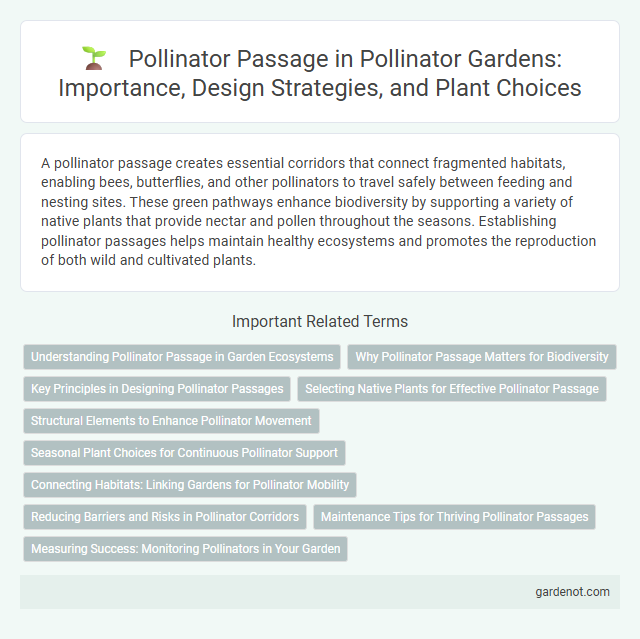A pollinator passage creates essential corridors that connect fragmented habitats, enabling bees, butterflies, and other pollinators to travel safely between feeding and nesting sites. These green pathways enhance biodiversity by supporting a variety of native plants that provide nectar and pollen throughout the seasons. Establishing pollinator passages helps maintain healthy ecosystems and promotes the reproduction of both wild and cultivated plants.
Understanding Pollinator Passage in Garden Ecosystems
Pollinator passage in garden ecosystems refers to the movement and travel routes of pollinators such as bees, butterflies, and hummingbirds between flowering plants. Effective pollinator passage ensures cross-pollination, enhances plant biodiversity, and supports ecosystem resilience by maintaining genetic diversity among plant populations. Designing garden layouts that include continuous flower patches, diverse plant species, and safe nesting habitats optimizes pollinator corridors and promotes healthy pollinator activity.
Why Pollinator Passage Matters for Biodiversity
Pollinator passages create vital corridors that connect fragmented habitats, enabling pollinators like bees, butterflies, and hummingbirds to access diverse floral resources necessary for their survival. These passages support genetic diversity by facilitating pollen transfer across plant populations, which enhances ecosystem resilience and productivity. Preserving pollinator passages mitigates habitat loss and promotes biodiversity by maintaining essential ecological interactions within pollinator gardens and surrounding landscapes.
Key Principles in Designing Pollinator Passages
Designing pollinator passages requires selecting native flowering plants that provide continuous bloom periods to support diverse pollinator species throughout the seasons. Incorporating habitat connectivity by linking fragmented green spaces enhances pollinator movement and genetic exchange. Minimizing pesticide use and including water sources further promote a healthy environment for pollinators to thrive.
Selecting Native Plants for Effective Pollinator Passage
Selecting native plants for an effective pollinator passage enhances local biodiversity by providing essential nectar and pollen resources tailored to indigenous pollinators such as bees, butterflies, and hummingbirds. Native species like milkweed, goldenrod, and coneflower support the life cycles of native pollinators, improving their survival and reproduction rates. Incorporating diverse native flora ensures continuous blooming periods, creating a sustainable and resilient habitat corridor that facilitates pollinator movement and genetic exchange.
Structural Elements to Enhance Pollinator Movement
Pollinator passages incorporate narrow corridors of native flowering plants and continuous structural elements such as hedgerows, shrubs, and ground cover to facilitate seamless pollinator movement across fragmented habitats. Diverse vertical layering and spatial arrangement of plants create sheltered pathways, reducing exposure to predators and harsh weather while promoting efficient foraging routes. Integrating features like flowering season overlap and strategically placed water sources enhances connectivity, supporting a robust pollinator network essential for ecosystem health.
Seasonal Plant Choices for Continuous Pollinator Support
Selecting a diverse range of native flowering plants ensures continuous nectar and pollen availability throughout the growing seasons, supporting a wide variety of pollinators. Early-blooming species like crocus and witch hazel provide vital resources in spring, while summer-bloomers such as milkweed and coneflowers attract butterflies and bees. Late-season plants like goldenrod and asters extend foraging opportunities into fall, maintaining habitat connectivity along the pollinator passage.
Connecting Habitats: Linking Gardens for Pollinator Mobility
Pollinator passages create crucial corridors that link fragmented habitats, enabling bees, butterflies, and other pollinators to move freely between gardens and natural areas. These connected green spaces increase foraging opportunities and genetic exchange among pollinator populations, strengthening ecosystem resilience. Designing pollinator passages with native flowering plants promotes biodiversity and supports pollinator health across urban and rural landscapes.
Reducing Barriers and Risks in Pollinator Corridors
Pollinator passages enhance habitat connectivity by reducing physical barriers that impede the movement of essential pollinators such as bees, butterflies, and hummingbirds. Strategic planting of native flowering species along corridors mitigates risks from pesticides and habitat fragmentation, promoting safer routes for foraging and breeding. These corridors support biodiversity by facilitating gene flow and increasing resilience in pollinator populations across fragmented landscapes.
Maintenance Tips for Thriving Pollinator Passages
Regularly pruning invasive species and deadheading spent blooms ensures continuous nectar sources for pollinators. Maintaining a diversity of native flowering plants supports various pollinator species throughout their active seasons. Avoiding pesticide use and providing adequate water supply further promote a healthy and thriving pollinator passage.
Measuring Success: Monitoring Pollinators in Your Garden
Monitoring pollinators in your garden involves regular observation and documentation of species diversity, visitation rates, and behavior patterns to gauge the health of your pollinator passage. Utilizing tools such as digital counters, photography, and identification apps enhances accuracy in tracking pollinator activity and species richness. Consistent data collection over time supports adaptive management strategies, ensuring your pollinator garden fosters sustainable habitats and promotes effective pollination services.
Pollinator passage Infographic

 gardenot.com
gardenot.com